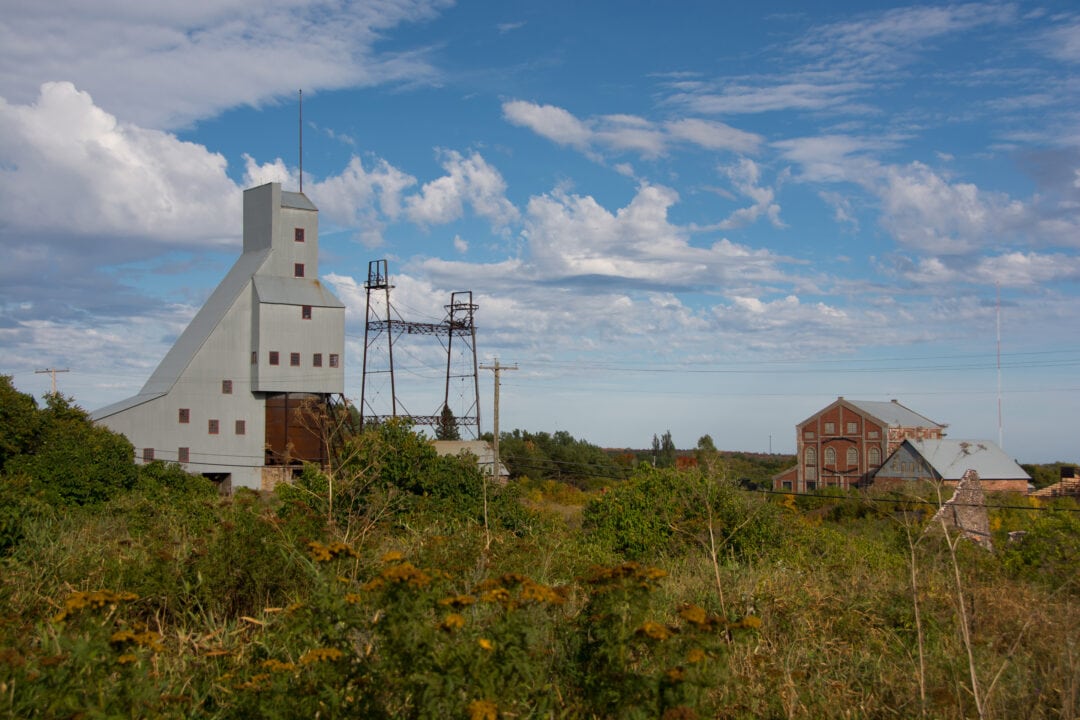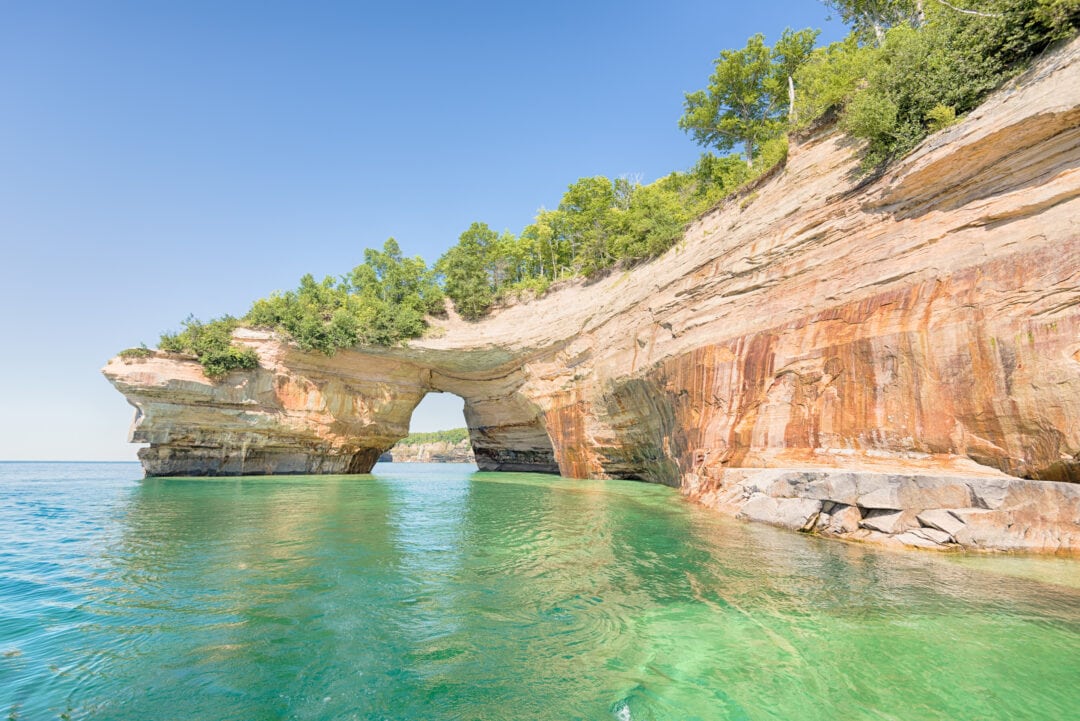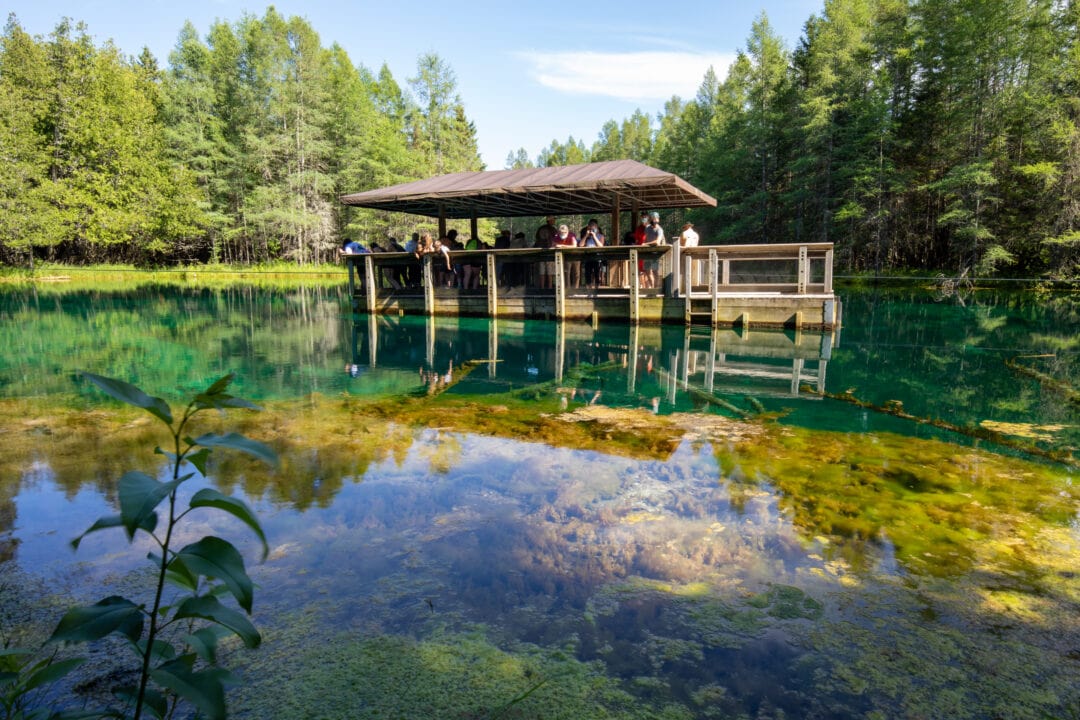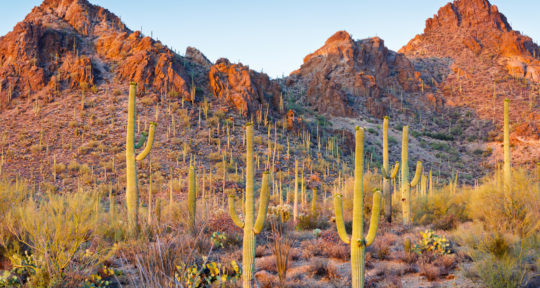There’s an old joke that asks, “Who lost the war between Ohio and Michigan?” The answer is: Wisconsin. In 1836, the Toledo War broke out between Ohio and Michigan over a strip of land bordering both states, which included the city of Toledo. As a condition of admittance to the Union in 1836, Michigan had to relinquish claims to the strip, and was given the 9,000 square miles of land that constitutes the Upper Peninsula (UP)—which is firmly attached to Wisconsin—as a consolation prize.
Though considered a poor deal for Michigan at the time, the later discovery of valuable copper and iron ore deposits in the region meant the bargain turned out well in the end.
Today, one of the biggest industries in the UP, or “Yoop,” is tourism. With 21 state parks and the Pictured Rocks National Lakeshore, it’s easy to see why the area has become a destination. Here are six must-see stops and destination types on a Yoop Loop road trip.


1. Porcupine Mountains State Park
No need to head west for sweeping mountain vistas and untouched landscapes—Porcupine Mountains Wilderness State Park, or the “Porkies,” offer incredible scenery, hiking, and mountain biking. And you don’t need to be a backwoods expert to get a taste of what this 60,000-acre park offers. Stop first at the visitor center, open daily from 8 a.m. to 8 p.m. between May and October. Sign up for interpretive programs and hikes and walk a 1-mile trail that winds through the largest old-growth hardwood-hemlock forest in the Great Lakes region.
To get a bird’s-eye view of the Porkies, stop at one (or all) of the park’s three spectacular lookouts. Lake of the Clouds Overlook is accessible via a 100-yard paved trail and offers a lovely view of the lake, surrounded by forests, that is especially gorgeous in the fall. Copper Peak and Summit Peak offer two more treetop vantage points. Copper Peak is the only ski flying facility in the Western Hemisphere and offers the highest unobstructed view in the Midwest; Summit Peak Observation Tower is the highest vantage point in the Porkies at nearly 2,000 feet above sea level. On a clear day, you’ll be able to see Isle Royale, the Apostle Islands, and Lake Superior. The one thing you won’t see, however, is an actual porcupine. Early explorers named the mountains after the prickly animals because they thought the outline of the trees perched on the ridges resembled the porcupine’s quills, not because any of the animals were around.
Ditch your car to experience Isle Royale, the least-visited national park in the contiguous U.S.
For RVers, Ontonagon Township Park sits on the shores of Lake Superior and is a short drive from the Porkies. Some of the campsites have beach access—just keep in mind that the water can be very cold.


2. Waterfalls
The UP is home to more than 300 waterfalls, including every waterfall in the state except one. Some of the most spectacular features are located in the western and central regions, and though they’re beautiful year-round, spring is the best time to see them.
Though there are several falls in and around Pictured Rocks National Lakeshore, there are plenty of others worth a visit all on their own. Agate Falls, just east of the Porkies, is on the middle branch of the Ontonagon River, and spills from nearly 40 feet over a shelf of terraced sandstone. Bond Falls, located near the Wisconsin-Michigan border, features water from the Ontonagon River cascading 50 feet down fractured rocks. Finally, Laughing Whitefish Falls, located between the towns of Marquette and Munising, is worth a visit just for the name. The falls cascade 100 feet through a picturesque gorge, surrounded by old-growth trees—visit earlier in the season, as the water can dwindle to a trickle once the snow melts.
–


3. Keweenaw Peninsula
The Upper Peninsula has a peninsula of its own: The Keweenaw Peninsula occupies the northernmost tip of Michigan, and it’s from here that visitors catch a ferry or seaplane to Isle Royale National Park.
Copper mining was big business in the Keweenaw—to get an idea of just how big, stop at the Keweenaw National Historical Park visitor center in Calumet, Michigan, which includes two floors of interactive exhibits. Then, take a guided tour of the abandoned Quincy Mine, in operation for 99 years, in Hancock.
Hungry for more history? Check out the Fort Wilkins Historic State Park, located 1 mile east of Copper Harbor. The fort was built in 1844 to coincide with the copper rush, and today features walking tours and costumed interpreters, reenacting historical life at the fort. There’s also a popular campground at the park, with walking trails and sites featuring a view of Lake Fanny Hooe. On your way to or from the fort, don’t miss the scenic 9.5-mile Brockway Mountain Drive, with an expansive view over the peninsula to Lake Superior. Along the way, you’ll find nature preserves and hiking and mountain biking trails.
Finally, make your last stop in the Keweenaw at the Eagle Harbor Lighthouse, built in 1871. Take a tour and stay for a spectacular sunset over Lake Superior.


4. Pictured Rocks National Lakeshore
If you can only make one stop in the UP, make it Pictured Rocks National Lakeshore. This long, narrow park hugs the shoreline of Lake Superior, starting just east of Munising and stretching for 42 miles. There are hiking trails, waterfalls, towering sandstone cliffs, sand dunes, beaches, inland forests, streams, and lakes—your hardest task will be deciding how to spend your time. There are visitor centers at either end; stop in at one to get your bearings before you start exploring.
One of the best ways to see the park is from the water. If you’re an experienced, confident kayaker with the right kind of vessel, you can head out on your own, but most visitors should consider either a guided kayak tour or boat tour to get a waterside view of 15 miles of cliffs.
Back on land, there are more than 100 miles of trails, with hikes ranging from less than a mile to a 42-mile through-hike. Plenty of the park’s hikes offer access to waterfalls, including the Sable Falls Trail, a 0.5-mile roundtrip trail with a view of Sable Falls from the bottom of 168 steps; and the 1.2-mile roundtrip Miners Falls Trail. It’s an easy hike through the forest to see the park’s most powerful waterfall as it cascades 50 feet down a sandstone cliff. To see it from the bottom, you’ll have to tackle another 64 steps. Iconic Bridalveil Falls is best viewed from the water, but it largely dries to a trickle by mid-summer.


5. Kitch-iti-Kipi
Michigan’s largest natural freshwater spring, located in Palms Book State Park, is definitely worth a detour through the central UP. Kitch-iti-Kipi, meaning “big, cold spring” in Ojibwe, lives up to its name. Check out the crystal-clear waters, also called the “Mirror of Heaven,” via a self-propelled raft. Turn the wheel to glide the raft over water that’s so clear you can see the trout swimming at the bottom. More than 10,000 gallons of water per minute gushes through the underlying limestone and remains at a constant 45 degrees Fahrenheit, so it never freezes, even in the depths of winter.
6. Pasty shops
You’ll find purveyors of the unofficial official food of the UP across the peninsula, and every Yooper will have an opinion about whose is best. Pasties, made by placing an uncooked filling into half of an uncooked pie crust, folding it over into a semi-circle, and crimping the curved edge to seal before baking, originated in Cornwall, England, and were particularly popular among miners. When Cornish miners immigrated to the UP to help develop the mines, they brought the pasty with them.
Nowadays they’re everywhere, and you must try one—or several—on your trip through the UP. Though they’re traditionally filled with beef, potatoes, onions, and rutabaga, today you can find all sorts of varieties in the area. Lawry’s Pasty Shop in Marquette is beloved for its beef pasties; The Pasty Oven in Quinnesec serves varieties including pepperoni pizza; and Irontown Pasties in Negaunee even serves a vegan pasty.






